Table of contents
What is an Umbanda line?
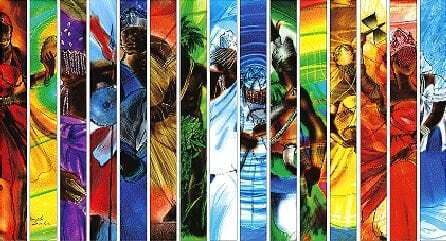
In the Umbanda religion the spiritual world is divided into groups, the first of these being the orixás, and then the groups of spirits that assist them. An Umbanda line is a large group, or army, of spirits that obey a specific Orixá and carry his characteristics in themselves.
For example, a sailor who is someone with a deep relationship with water belongs to the line of Yemanjá who is the queen of the sea, or caboclo (indigenous) who is in the line of Oxóssi who is the lord orixá of the woods and forests.
Read in this article all about the seven lines of Umbanda, what are they, which orixás are governed by, what are their functions and main characteristics, besides knowing the principles of the Afro-Brazilian religion Umbanda.
Understanding Umbanda
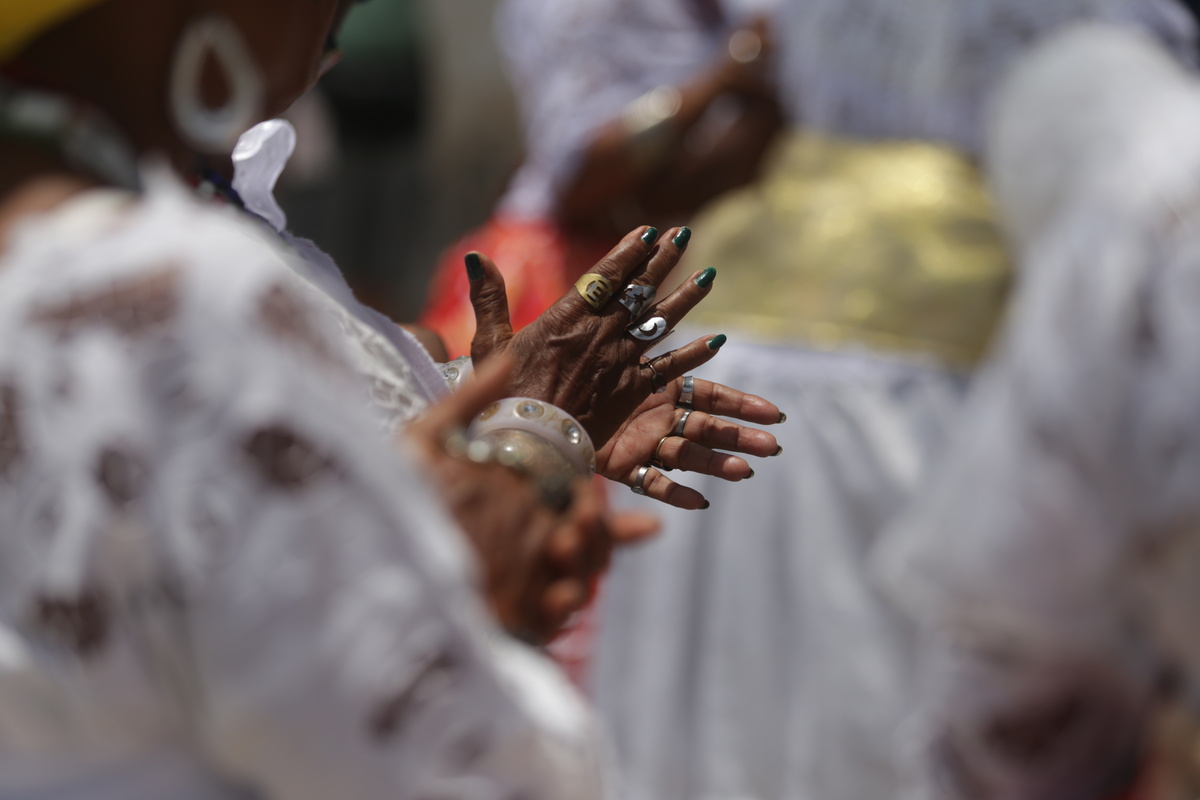
Umbanda is one of the most widespread and well-known religions in Brazil, being considered one of its official religions. However for many its principles and beliefs are still unknown, and sometimes feared, due to lack of access to real information about it.
Read about the religion and learn about what it is, how it came about, what the principles of Umbanda are, what religious syncretism is and why it is so important in the emergence of this essentially Brazilian religion.
What is Umbanda?
Umbanda is a religion of Afro-Brazilian matrix that emerged in the early 20th century, resulting from the union of the beliefs of African peoples such as Candomblé, the spiritist doctrine from Europe, more specifically from France, and the Christian religion that came with the Portuguese colonizers to Brazil.
The meaning of the name varies a little according to the source, but it is believed that the word Umbanda belongs to the Quimbundo vocabulary from Angola, meaning "magic" and "art of healing". It presents some variations in each center, tent or terreiro, since it is not a religion with immutable rules or a single book that governs it.
It has different branches, some are more Christian, others are closer to Candomblé, and others follow a new path, among them are: traditional Umbanda, mixed, esoteric, sacred and astrological. But all are guided by faith in the orixás, the immortality of the soul, faith in the spirits, and charity.
How did Umbanda come about?
Umbanda officially emerged on November 15, 1908, having been announced by medium Zélio Fernandino de Moraes (1891-1975). At the beginning of the 20th century, Zélio, still young, already had mediumistic abilities and frequented the spiritist center of his city.
In a certain day his personal guide, the Caboclo of the Seven Crossroads, descended in him during a session in that spiritist center, however for the Kardecist spiritist doctrine this kind of spirit is not evolved and, therefore, could not be there in their mediumistic session. And so they asked the entity to leave.
After this episode Zélio, receiving instructions from his Caboclo, inaugurated the religion known as Umbanda, and opened the first Umbanda tent called Tenda Espírita Nossa Senhora da Piedade, in the city of São Gonçalo in Rio de Janeiro.
And in this new religion spirits like those of Indians, old men who were slaves, sailors and drovers, who in life were always placed on the margins of society have their space and their importance, and with their earthly and spiritual knowledge are allowed to help and advise the living.
Umbanda Principles
Umbanda has as its principles the light, charity and love. And its form of work for this purpose is performed through rites called giras, which involve songs sung and played with drums called pontos, the use of candles, herbs, offerings, passes for energetic purification, baptism, smoking, points and discharge, which are energetic cleansings aimed at releasing theperson from the influence of an ill-intentioned spiritual, popularly known as a caster.
As well as the characteristic for which the religion is best known and misunderstood, the incorporation of mediums by spirits and entities. In Umbanda, unlike Candomblé, the orixás do not incorporate into people, because according to Umbanda they are made of energies much more powerful than a person could handle, and that's where the 7 lines of Umbanda come in.
In each one of the 7 lines, there are spirits that work with the characteristics of a certain Orixá, so that the incorporation in the mediums is made by one of these spirits that assume the face of a spirit type, like the sailor, the caboclo, the pomba-gira and so on.
His entire ritual is done with the help of more enlightened spiritual friends, to promote the spiritual purification of those present in general, and in private conversations between the entity and the consulter, where advice is given on situations of their particular life, always aiming at their evolution and learning.
What is religious syncretism?
Syncretism is the fusion or mixture of different philosophies, ideologies, social systems or cultural elements. Thus religious syncretism is nothing more than the mixture between religions, sometimes founding a new religion, or sometimes simply changing two existing ones.
In the context of Umbanda, which is a religion founded from the union of beliefs from three previous religions, syncretism happens strongly and is very well known regarding its worshipping entities. Umbanda is a religion that has elements of candomblé and Christianity and to understand how these two doctrines came together we need to look at the history of Brazil.
After the discovery of the country and the failed attempt to try to enslave the indigenous people who lived here, the Portuguese brought slave labor from Africa. And the treatment meted out to enslaved people aimed to erase any trace of their past, their beliefs and identity and anything that might give them strength to rebel, hope or bond with other enslaved people.
Among these attempts to erase their culture was the prohibition of keeping their original religious cults, and when this happened they were severely punished. So to be able to keep their faith and continue to worship their gods, the enslaved started to disguise their entities in Catholic saints that had similar characteristics.
Some examples are Yansã and Santa Barbara who rule thunder and storms, Ogum and Saint George who are warriors, and Oxalá and Jesus who bring the energy of love and peace.
So it is not uncommon until today when entering an Umbanda tent to see Catholic saints on the altar, because if before this was done to disguise, today for the Umbanda people, who have their religion as a result of syncretism, both are the representation of the same energy.
What are lines in Umbanda and what is their function?
The term 7 linhas da Umbanda is very popular because Umbanda is a very widespread religion, but sometimes people hear it without knowing what it means or what exactly are these lines. So find out below what are the 7 lines of Umbanda, what are they for and what are the main characteristics of the lines of Oxalá, Yemanjá, Xangô, Ogum, Oxóssi, Iori and Iorimá.
The lines of Umbanda are the spiritual groupings that can be called armies or legions that help a particular orixá. An orixá guides this line and their spirits follow the characteristics of it, and these spirits are known as entities called Caboclo with their various sub-denominations as the Caboclo Sete Flechas or Cabocla Jurema, and others.
Their function is to help the orixás in their contact with humans, because the orixás have such great energy that they cannot communicate with people through incorporation, and so they send their auxiliaries to help people in their life needs.
Oxalá - Religious Line
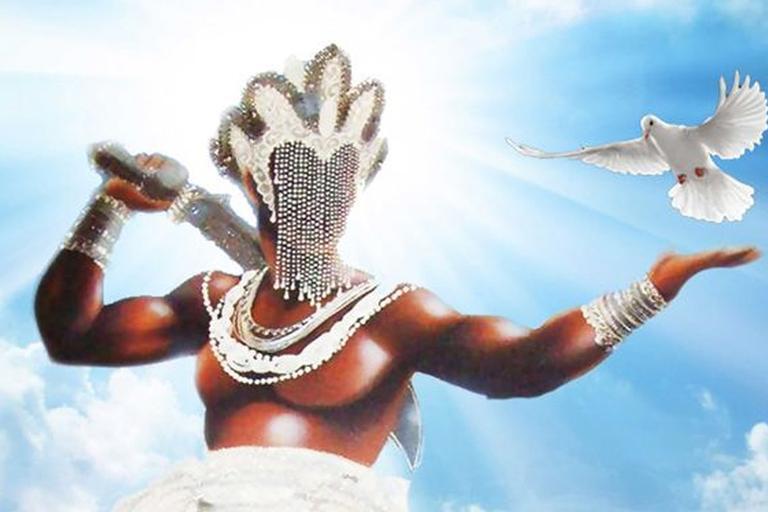
The religious line is ruled by the orixá Oxalá and although according to some ideologies there is not a fixed order of the lines, which can change from terreiro to terreiro, there is a consensus that the Oxalá line is always the first of the seven lines of Umbanda, since he is the most important orixá and for this reason this is the line that commands all the others.
Despite this case, it does not mean that there is a greater or lesser degree of importance in the sequence of the other lines, or among the other orixás.
Element
The element of the religious line, or of Oxalá is the crystal. The translucent stone is famous for its high energetic power, being able to heal and transform energies and to transmute a beam of light into a rainbow, metaphor for the abilities and characteristics of this orixá.
Color
The color of the orixá Oxalá is white, which represents the greatest peace, the spiritual. This orixá came from the air and is responsible for faith and religion, so the color white refers to his pure spirit, kind, full of peace, serenity and love.
Syncretism
In syncretism Oxalá is presented as Jesus Christ, because both carry the same characteristics of faith, love, goodness, light, truth, peace and charity, and also being both, the leaders of their respective religions.
Composition
The religious line or Oxalá is composed by entities as the pretos-velhos and the caboclos. And also the catholic saints, the people from the east also known as the monks, the masters of the religions from there and in general people that were strongly related to the spirituality in the eastern molds.
Function and characteristics
This line represents the beginning, that which has not yet been created, faith, religiosity and the reflection of God. It is the reflected light that influences all vibrations. The entities that participate in this line are soft-spoken and express themselves with great spiritual elevation. The sung points of oxalá invoke high mysticism, however they are rare to be heard because they hardly assume leadership ofhead.
Yemanjá's Line - Line of the water people
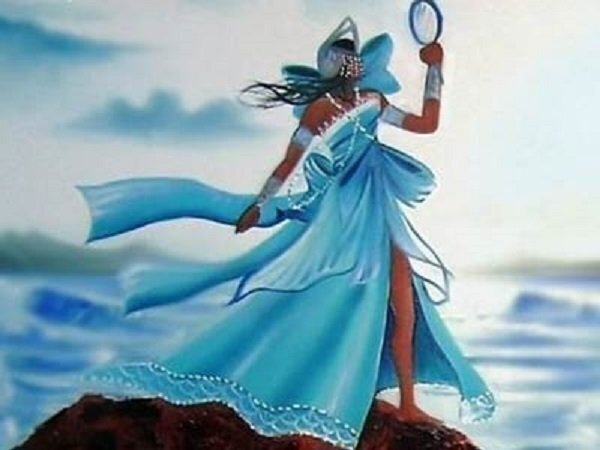
The Water People line is ruled by Yemanjá, the mother of the sea waters. This is the most feminine line that works with the power of the sea and salt water, and also with pregnancy, as Yemanjá is known to be considered a mother who nurtures and protects her children.
Element
The element of the line of the water people, of Yemanjá is the element of water, because this orixá is the queen of the waters of the sea, and therefore she and her phalanxes work through this element.
Color
The color of Yemanjá's line is blue, or light blue, a color that transmits strength, peace and tranquility, qualities that are found in the waters of the sea.
Syncretism
In the syncretism Yemanjá becomes Nossa Senhora da Conceição, but is also known in each region by other denominations as Nossa Senhora dos Navegantes. Both have the same qualities, being patron saints of sailors, fishermen and rafters, protecting their incursions into the waters of the sea.
Composition
The line of water people is composed of entities known as ondinas, as well as female orixás such as mermaids, iaras, naiades, nymphs, caboclas of the rivers, springs and waterfalls, and the famous sailors.
Function and characteristics
Yemanjá represents the generating energy, the eternal feminine, the mother of the universe and of Umbanda. The entities of this line feel at ease in works that involve salty water, preferably from the sea, to fix their vibrations in a calm way. And her sung point has beautiful rhythms that talk about the sea.
Xangô Line - Line of Justice
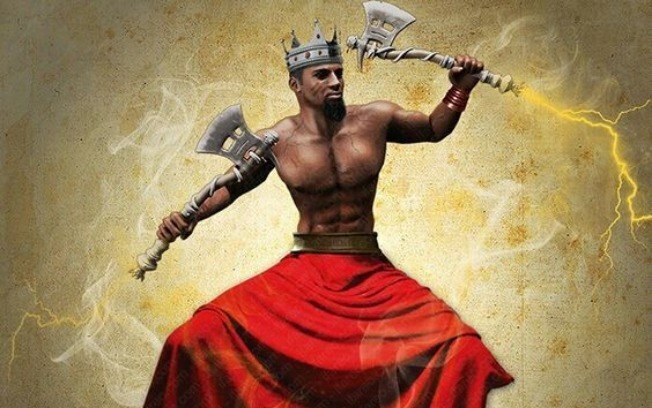
The line of justice is ruled by the orixá Xangô who is the one who coordinates the laws. He is the leader of souls, the lord of the scales of universal justice, therefore his line works with everything that involves justice and the laws of the world. This orixá also works with the law of cause and effect.
Element
The element of the line of justice, the line of Xangô is the element of fire. Xangô is accompanied by fire and everything that surrounds it, like volcanoes, lightning and thunder. Everything that demonstrates and represents strength and change in nature.
Color
The color of the Xangô line in Umbanda is brown, since this orixá is very connected to nature and quarries.
Syncretism
In syncretism, the orixá Xangô is transformed into Saint Jerônimo, since this saint is patron saint of the same elements of nature as Xangô, besides both having a connection with laws and judgments.
Composition
The line of justice or Xangô line is composed of entities such as caboclos, pretos-velhos, in addition to police officers, jurists and lawyers. Where all are connected through the sense of justice they carry in their essences.
Function and characteristics
This line coordinates everything related to reason and justice, so that this orixá is responsible for ensuring that people receive what they have sown, whether it is good or bad. And besides punishing, he also protects the wronged.
In this line they also work Santa Bárbara (Yansã) and Saint Michael Archangel, who have similar energies. And the points sung lead to vibrational places like waterfalls, mountains and quarries.
Ogum's Line - Line of Demands
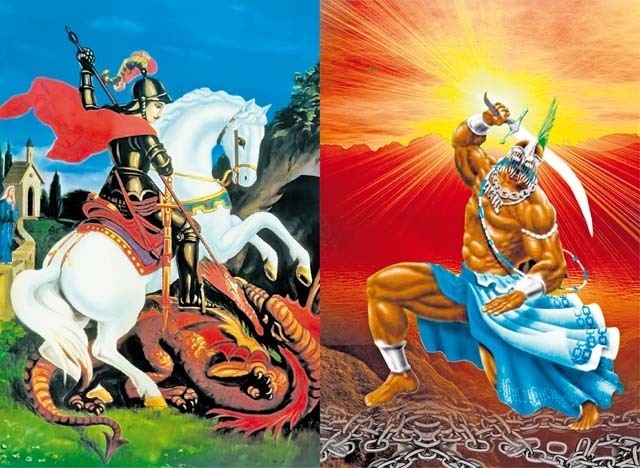
The line of demands is ruled by Ogum who is the orixá that brings in its vibration the fire of salvation and glory, being he the mediator of the shocks arising from karma. This orixá is a great warrior and for this reason the line of Ogum helps in the afflictions of faith and in the battles of day-to-day life, also stimulating the balance and order, besides opening paths to keep away enemies.
Element
The element of the Ogum line is also fire, since the orixá is the one who fights battles for humans, he is the ruler of the line of demands, that is, of requests. His element is fire because this is the element that acts in transformations and gives the necessary energy for the battles of life.
Color
The color of the line of demands is red and this is because the orixá Ogum is a great warrior who fights for those who ask for his help in the battles of life. Red is also the color of fire, the element that rules him.
Syncretism
In syncretism the orixá Ogum is known as Saint George, being one of the best known and worshiped saints in Brazil. Both have a very similar profile, because while Ogum is a great warrior Saint George is a saint who was a soldier of the Roman Empire, besides the color that represent them is red, and both protect soldiers, military and blacksmiths.
Composition
The line of demands or Ogum is composed of entities known as caboclos, exus de lei, baianos, boiadeiros, gypsies and military. These spirits connect because they deal in their stereotypes with battles or maintaining order, two of the main characteristics of Ogum.
Function and characteristics
This is the line responsible for faith, which fights the afflictions, struggles and battles of life. This orixá protects the warriors, in every sense that this word can have today. The caboclos of Ogum are those who behave in a serious manner and speak in a strong and vibrant way, and in their attitudes are full of energy. Their sung prayers make invocations for the battle, the wars and the fight for faith.
Oxóssi Line - Line of Caboclos
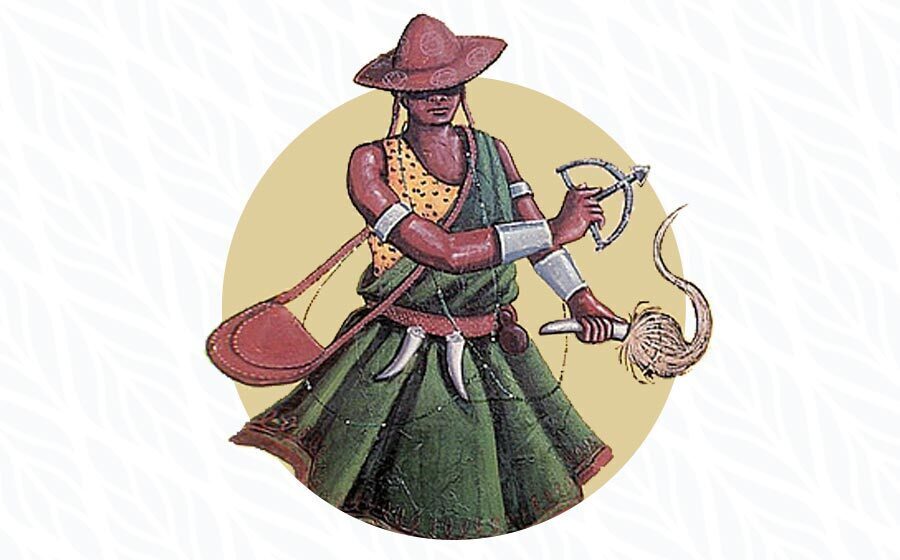
The caboclo line is ruled by Oxóssi and this orixá, who is the hunter and lord of the forests, through his vibration brings an involving action for the living. Oxóssi has great connection with nature and animals, and seeks to protect all those who need it, the oppressed and weak. In addition, he is the orixá of knowledge, being curious and analytical, seeking to reach the truth about things by hisown account.
Element
The element of the caboclo line, or of Oxóssi, is the vegetal. This is because he is the orixá of the forests and, therefore, he rules everything that is there; the vegetal world, the plants and the herbs.
Color
The color of the Oxóssi line is green because of its proximity, its connection to the woods and forests. Because it is also the color of the plant element, which is the element ruled by this orixá.
Syncretism
In syncretism the orixá Oxóssi becomes São Sebastião. The proximity that both have between them is that both are warriors who fight for justice for those who cannot defend themselves. Besides, an iconographic point connects them, São Sebastião died by arrows, and Oxóssi is a hunter of the woods, and his most commonly represented weapon and symbol is the bow and arrow.
Composition
The line of Oxóssi, who is the hunter and warrior orixá king of the forests and jungles is composed of caboclos and caboclas, in other words, indigenous people, as well as boiadeiros, who in general also live around the jungle.
Function and characteristics
The Oxóssi line, or the caboclo line, is also very focused on knowledge and its entities speak in a firm but calm way, so are their advices and works. Their sung points are to invoke forces of spirituality and of nature, of the forests.
Iori Line - Children's Line
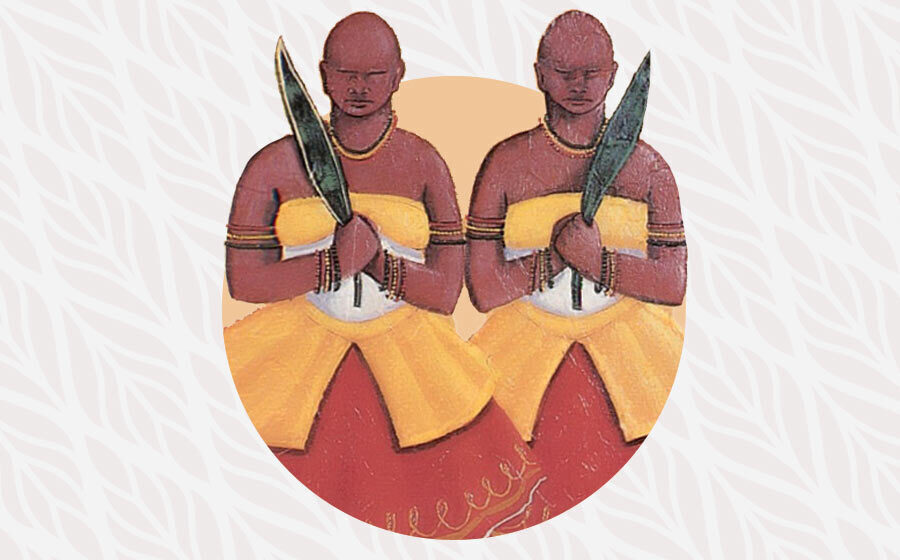
The line of children is known as the Iori, or line of Ibeji, who are the candomblé correspondents of the brothers Cosme and Damião. These entities symbolize the purity, goodness and innocence of childhood. This is the line of love, renewal and evolution.
Element
The element of the Iori line is fire, for like fire, children are full of energy and life, and like the qualities that children naturally possess, fire brings purity and transformation to everything it touches.
Color
The color of the children's line is pink, which brings the feeling of sweetness and innocence typical of this phase of life.
Syncretism
In syncretism there is a connection of the line of Iori, which is not an orixá, but an energy linked to children, mainly to Ibeji who are twin children entities, which are close to the brothers Saint Cosme and Damian.
Composition
The Iori line is composed of the famous Ere, or children, both boys and girls of all races. Entities that despite behaving like small children, are highly evolved and give deep and wise advice with words that could be said by completely innocent children about life.
Function and characteristics
These entities manifest themselves through childlike gestures, voices and ways of behaving and speaking, sometimes quiet sometimes agitated, as children really are. They like to eat sweets and drink soft drinks while giving their very evolved and serious advice. Children's points can be sad or joyful, and they generally speak of heavenly papa and mama and holy robes.
Linha de Iorimá - Line of Souls
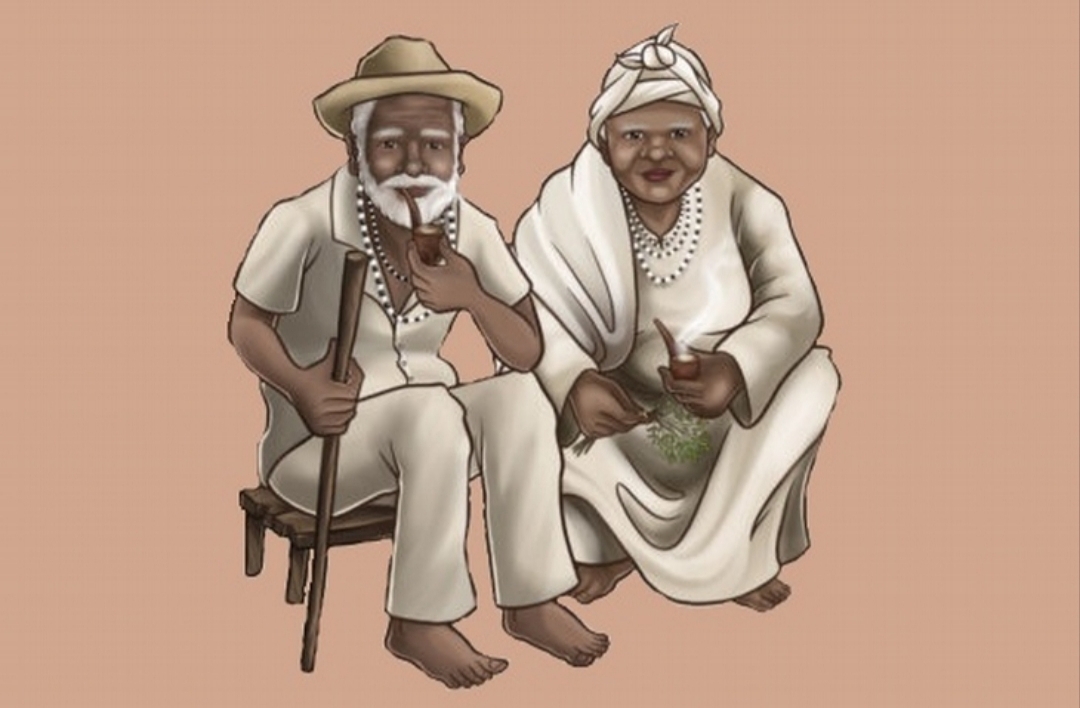
The line of souls is ruled by Iorimá, which like Iori, is an energy, not an orixá. This energy carries love, understanding, humility and wisdom, comforting the afflicted and reviving the weak. This is the line of the famous pretos-velhos and it is designated to fight evil whenever it manifests itself.
Element
The element of the line of souls is the earth, for besides other things they work much through the elements given by the earth, such as plants, herbs, and crystals.
Color
The color of the Iorimá line is violet, which represents wisdom and tranquility. Both qualities are present among the main characteristics of the elderly, or for Umbanda, the pretos-velhos.
Syncretism
In syncretism, the energy of Yorimá is manifested in Saint Benedict, because like the pretos-velhos, the saint has a history of generosity and humility, and both use nature for healing.
Composition
The line of souls is composed of elderly black women and men, known as pretos and pretas-velhas from all nations. And these entities manifest themselves by speaking slowly and with an ancient way of saying, always being very affectionate. They think a lot before speaking and advise in a serene manner.
Function and characteristics
This line is composed of the first spirits to combat evil in all manifestations, who are ancient, wise and very evolved souls who present themselves as prestos-veligos who teach and practice the "mirongas", that is, manipulate energies.
They usually work sitting down, smoking a pipe and drinking coffee, always bent over due to their advanced age. The sung points have melancholic melodies with a rhythmic beat and sometimes tell stories of the slavery era and talk about their knowledge.
Is there a difference between line and phalanx in Umbanda?
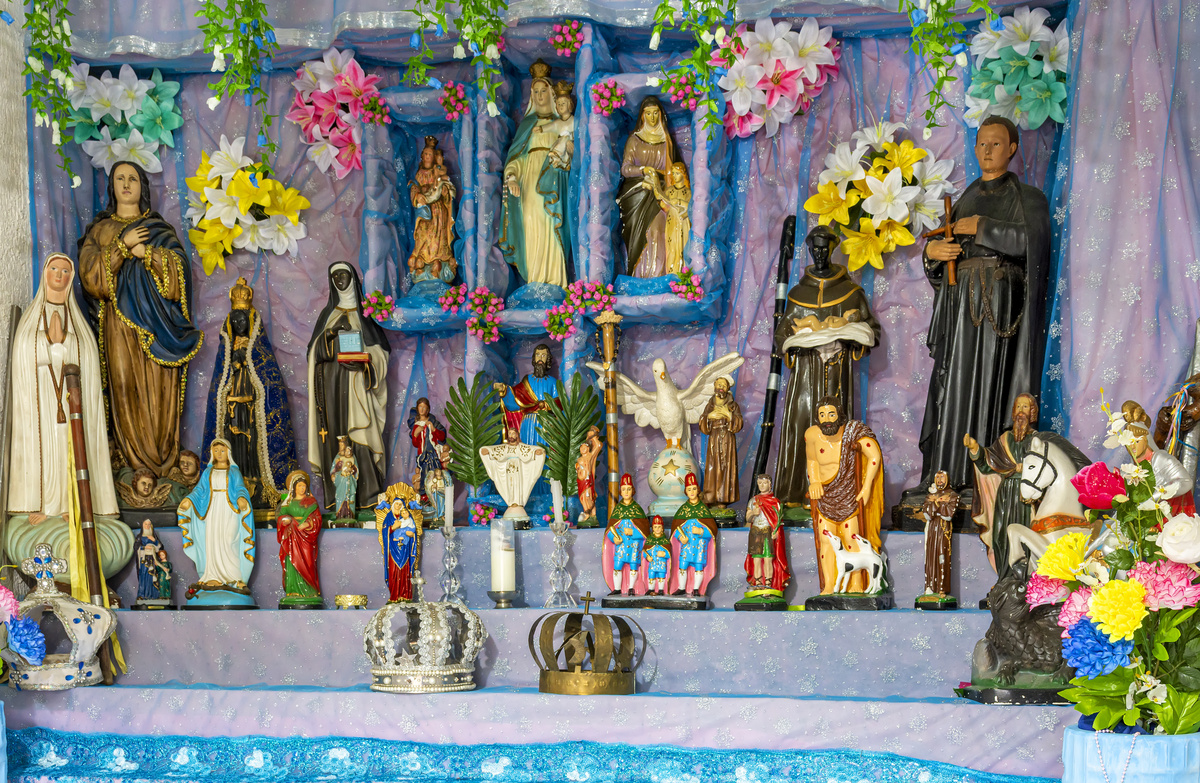
The lines and phalanxes of Umbanda are not the same thing, but they are an integral part of each other. The lines of Umbanda are the armies or legions that obey a specific orixá. These legions in turn are divided into 7 major phalanxes, other groups of spirits that in turn also have their chiefs.
To make it clearer, the spiritual organization of Umbanda is: the orixás, followed by the spiritual entities of their lines as caboclos, sailors and so on, and in the phalanxes are the human spirits, known as falangeiros.
These are in evolution and already work for the spiritual world, using the names of their chiefs when they lower in their mediums on Earth, so it is very common to see entities with the same name in different terreiros or tents. To give an example, Óxossi is the orixá that has the caboclos in its line, and within the phalanx of caboclos is the Caboclo 7 arrows, and so the phalanxes of this entityassume their name when they descend into their medium on earth.
In this article you could learn more about the origins and principles of the Afro-Brazilian religion Umbanda, and delve a little deeper into one of its aspects, the meaning of its important 7 lines of Umbanda, its orixás and its main characteristics. If you like it and want to know more, see our website for other articles about Umbanda and religiosity.

